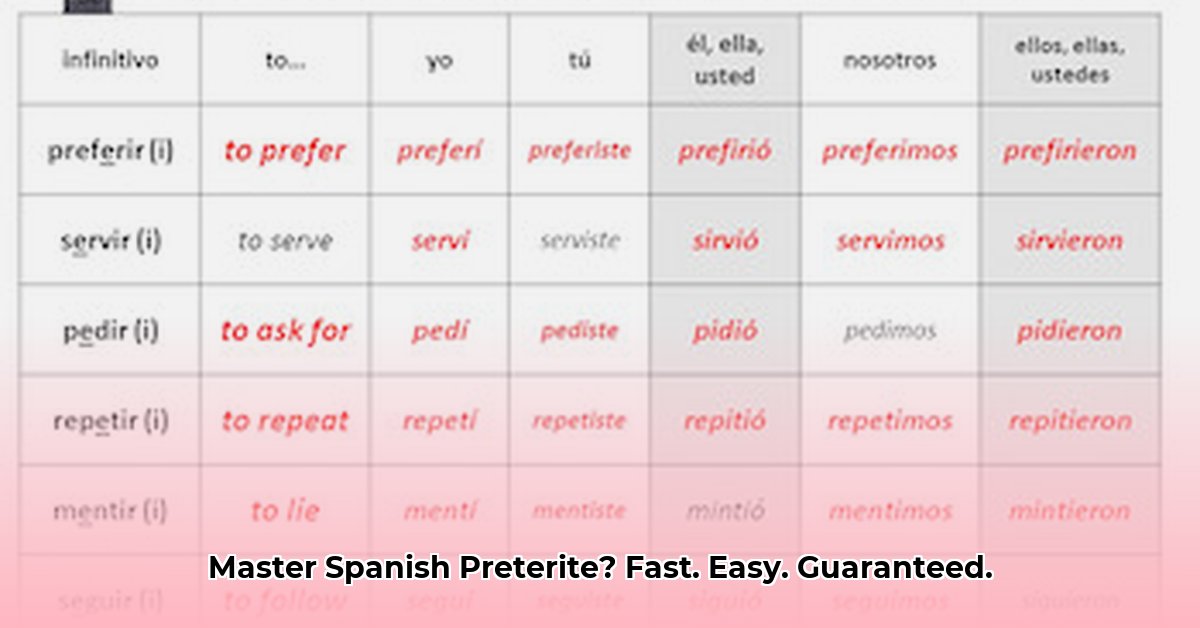
Ready to conquer the Spanish preterite tense and unlock a new level of fluency? This comprehensive guide provides a step-by-step approach, complete with integrated quizzes, to help you master this crucial verb tense. We'll break down regular and irregular verbs, explore common pitfalls, and offer practical tips and tricks to make learning both effective and enjoyable. Let's begin your journey to preterite proficiency! For extra conjugation help, check out this helpful resource.
Understanding the Preterite: Completed Actions in the Past
The preterite tense in Spanish describes actions that are completely finished—actions that happened and are now over. This contrasts with the imperfect tense, which describes habitual actions, ongoing states, or actions in progress. For instance, "Ayer comí pizza" (Yesterday I ate pizza) uses the preterite to describe a single, completed action. However, "Siempre comía pizza los viernes" (I always used to eat pizza on Fridays) uses the imperfect to describe a habitual action. Mastering this distinction is vital for accurate and fluent Spanish. How confident are you in distinguishing between the preterite and imperfect already?
Regular Verb Conjugation: Establishing a Solid Foundation
Regular verbs in the preterite follow predictable patterns based on their infinitive endings (-ar, -er, -ir). This consistency makes them a great starting point for your preterite journey. Let's look at some examples:
| Pronoun | -ar Verb (Hablar - to speak) | -er Verb (Comer - to eat) | -ir Verb (Vivir - to live) |
|---|---|---|---|
| Yo | hablé | comí | viví |
| Tú | hablaste | comiste | viviste |
| Él/Ella/Ud. | habló | comió | vivió |
| Nosotros | hablamos | comimos | vivimos |
| Vosotros | hablasteis | comisteis | vivisteis |
| Ellos/Uds. | hablaron | comieron | vivieron |
Practice Exercise 1: Conjugate the following verbs in the preterite: cantar (to sing), beber (to drink), and escribir (to write).
Irregular Verb Conjugation: Mastering the Exceptions
Irregular verbs, while more challenging, are essential for fluent Spanish. They don't follow the regular patterns. However, we will tackle them strategically.
Frequently Used Irregular Verbs
Let's start with some of the most common offenders. Consistent practice with these will significantly boost your confidence. Mastering these high-frequency verbs will make a considerable difference in your overall fluency.
- Ser (to be): fui, fuiste, fue, fuimos, fuisteis, fueron
- Ir (to go): fui, fuiste, fue, fuimos, fuisteis, fueron
- Hacer (to do/make): hice, hiciste, hizo, hicimos, hicisteis, hicieron
- Dar (to give): di, diste, dio, dimos, disteis, dieron
- Ver (to see): vi, viste, vio, vimos, visteis, vieron
Practice Exercise 2: Conjugate ser, ir, hacer, dar, and ver in the preterite.
Memory Aids and Strategies
For irregular verbs, employ effective memorization techniques. Flashcards, spaced repetition software, and creating sentences in context are all highly effective methods. What works best for you is key to success. "Finding your learning style helps immensely," notes Dr. Elena Ramirez, Professor of Spanish at the University of California, Berkeley.
Reflexive Verbs in the Preterite: Actions Directed Inward
Reflexive verbs, such as lavarse (to wash oneself), describe actions performed on the subject. To conjugate them, simply add the appropriate reflexive pronoun (me, te, se, nos, os, se) before the conjugated verb.
Practice Exercise 3: Conjugate the reflexive verb lavarse (to wash oneself) in the preterite tense.
Time Adverbials: Contextual Clues for Tense Selection
Time expressions provide crucial context for choosing between the preterite and imperfect. Words and phrases like ayer (yesterday), anoche (last night), and la semana pasada (last week) typically indicate the preterite, signaling completed actions.
Practice Exercise 4: Write five sentences using the preterite and appropriate time expressions.
Final Quiz: Assessing Your Preterite Proficiency
This concluding quiz will test your comprehension of everything we've covered. (Insert concluding quiz here)
Consistent practice is key to mastering the Spanish preterite. Keep reviewing, practicing, and using this tense in your conversations to solidify your understanding. ¡Ánimo! (Go for it!)